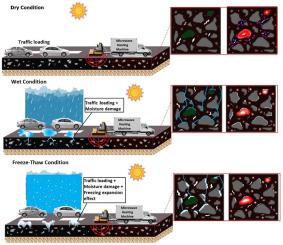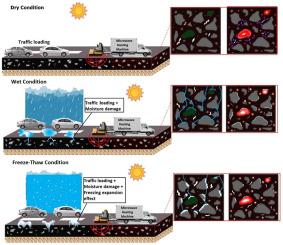含有钢渣的自愈合冷拌沥青:清洁生产的可持续解决方案
IF 9.7
1区 环境科学与生态学
Q1 ENGINEERING, ENVIRONMENTAL
引用次数: 0
摘要
与需要高温搅拌和压实的热拌沥青相比,在环境温度下生产的冷拌沥青产生的二氧化碳排放量要低得多。然而,人们担心冷拌沥青在暴露于各种环境压力下时耐久性较差,从而导致裂缝的形成。本文探讨了粗矿渣和粉状矿渣混合应用的益处,通过使用微波辐射来增强冷拌沥青的裂缝愈合能力。为此,我们对含有钢渣的干、湿和冻融冷拌沥青中微波诱导的愈合程度进行了量化。通过吸收电磁波产生的热量促进了后期愈合。热成像分析表明,在粗钢渣(4.75 毫米)中加入钢渣粉(0.075 毫米)后,试样和裂缝区域内的热分布更加均匀。研究进一步发现,冻融状态下的试样明显受益于微波诱导的愈合,半圆形弯曲强度恢复了 74%。这种增强归因于加热裂缝表面的扩散和接触面积增加。总的来说,对冷拌沥青试样进行微波处理后,粘结剂的润湿性和集料涂层都得到了提高,从而改善了性能。值得注意的是,刚度模量的改善最为明显,干拌、湿拌和冻融试样的刚度模量分别提高了 23%、46% 和 70%。通过提高冷拌沥青的耐久性,使其成为热拌沥青的可行替代品,研究结果支持了实现净零碳排放路面的愿景。本文章由计算机程序翻译,如有差异,请以英文原文为准。


Self-healing cold mix asphalt containing steel slag: A sustainable approach to cleaner production
Cold-mix asphalt, produced at ambient temperatures, generates significantly lower CO2 emissions compared to hot-mix asphalt, which requires high-temperature mixing and compaction. However, concerns have arisen regarding the lower durability of cold-mix asphalt when exposed to various environmental stressors, leading to the formation of cracks. This paper explores the benefits of a hybrid application of coarse and powdered slag to enhance crack healing in cold-mix asphalt through the use of microwave radiation. To do so, we quantified extent of microwave-induced healing in dry, wet and freeze-thaw conditioned cold mix asphalt containing steel slags. Latter healing is facilitated by heat generated via absorption of electromagnetic waves. Heat distribution within the specimens and crack zone found to be more uniform when the coarse slag (>4.75 mm) was supplemented with slag powder (∼0.075 mm) as evidenced by thermography analysis. It was further found that freeze-thaw conditioned specimens significantly benefited from microwave-induced healing as evidenced by a 74% recovery in semi-circular bending strength. This enhancement is attributed to the increased diffusion and contact area at heated crack surfaces. Overall, microwave treatment of cold mix asphalt specimens showed an increase in binder wettability and aggregate coating, resulting in improved performance. Notably, the most significant improvements were observed in the stiffness modulus, with increases of 23%, 46%, and 70% for dry, wet, and freeze-thaw conditioned specimens, respectively. Study outcomes support the vision toward the NetZero carbon emission pavements by promoting the durability of cold-mix asphalt to be a viable alternative to hot-mix asphalt.
求助全文
通过发布文献求助,成功后即可免费获取论文全文。
去求助
来源期刊

Journal of Cleaner Production
环境科学-工程:环境
CiteScore
20.40
自引率
9.00%
发文量
4720
审稿时长
111 days
期刊介绍:
The Journal of Cleaner Production is an international, transdisciplinary journal that addresses and discusses theoretical and practical Cleaner Production, Environmental, and Sustainability issues. It aims to help societies become more sustainable by focusing on the concept of 'Cleaner Production', which aims at preventing waste production and increasing efficiencies in energy, water, resources, and human capital use. The journal serves as a platform for corporations, governments, education institutions, regions, and societies to engage in discussions and research related to Cleaner Production, environmental, and sustainability practices.
 求助内容:
求助内容: 应助结果提醒方式:
应助结果提醒方式:


